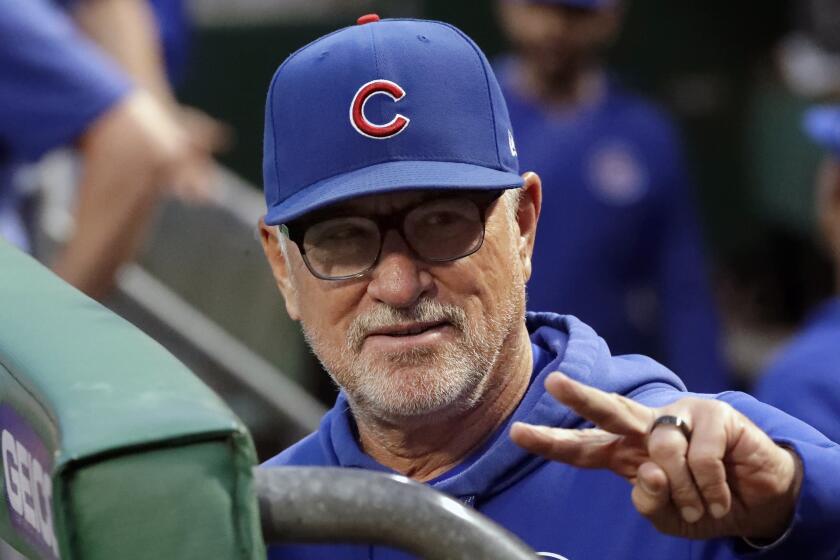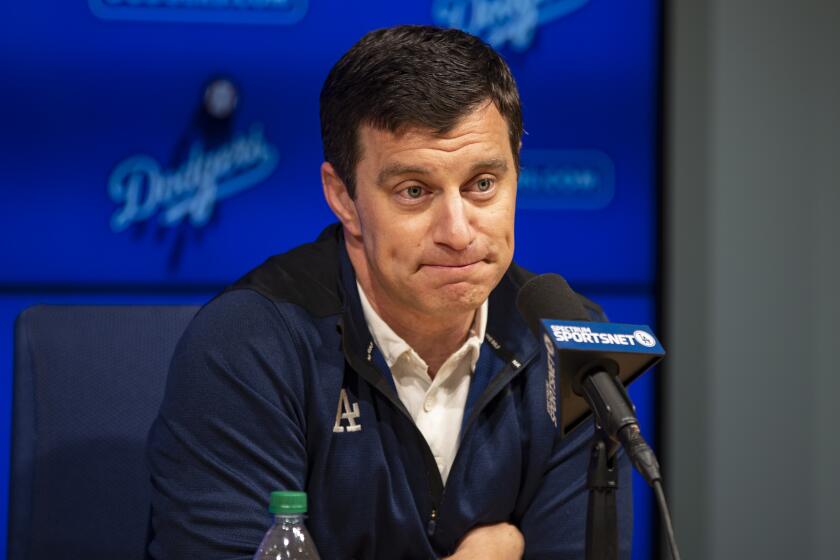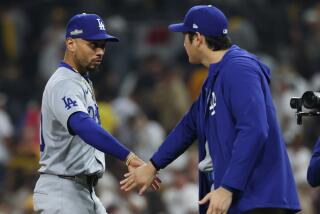MLB’s next collective bargaining agreement could reward younger players sooner

- Share via
NEW YORK — The Dodgers and Angels are done for the year. For the moment, let’s play a different kind of baseball game. This one is a thought exercise.
Baseball has not endured a work stoppage since 1994. The owners insisted upon a salary cap. They lost. The sport has prospered since.
In the last quarter-century, the owners tweaked baseball’s compensation system so artfully that the players are now effectively working under a salary cap, without the formal name. If the players threw up their hands and finally accepted a salary cap now in order to get a better financial deal for their members, how would the owners respond?
With glee? Not necessarily.
Thanks but no thanks? Just maybe.
To be clear: The players’ union does not intend to propose a salary cap, let alone agree to one as the two sides prepare for negotiations ahead of the expiration of the current collective bargaining agreement after the 2021 season.
“That’s not going to happen, ever,” a union official said.
Also, to be clear: The owners do not plan to pitch a salary cap.
“You would not hear us propose a cap at all,” a league official said.
There is no need for the owners to do that.
The Houston Astros in 2017 and Chicago Cubs in 2016 traded top prospects and were rewarded with World Series titles. The Dodgers similarly ought to go all in.
A salary cap is about competitive balance? LOL. The NBA and NFL have salary caps. In the last six years, the 12 possible slots in the NBA Finals were filled by five teams, in the Super Bowl by seven teams, and in the World Series by nine teams. There are 92 franchises in those three sports.
The point of a salary cap is to contain costs. And, in the 25 years since the salary cap was rebuffed by the players, the owners devised plenty of ways to cut costs.
Spend however much you want to sign a draft pick? No longer allowed. Spend however much you want to sign prospects out of Latin America? No more. Spend whatever you like on a player jumping from pro leagues in Japan or South Korea? Not unless the player is old enough, and has enough experience. (This provision almost certainly saved the Angels more than $100 million when they signed Shohei Ohtani.)
Pay a minor leaguer a living wage? MLB could, but the owners successfully lobbied Congress for federal legislation that only requires teams to pay minimum wage and specifically exempts them from paying overtime. Oh, and the owners have made a proposal to shut down a few dozen minor league teams.
Pay free agents? For all but elite players, analytics often suggest a team can get a comparable performance from a younger, much less expensive player.
A salary cap system could mandate a minimum payroll, which would provide baseball’s version of middle-class jobs at a middle-class wage, but why would small-market teams want to be forced to increase their payroll? The Tampa Bay Rays made the playoffs with the lowest payroll in the major leagues.
And, for large-market teams, the luxury tax has become a soft cap. No owner runs his team like George Steinbrenner any more — not even his son Hal, who succeeded his late father as steward of the New York Yankees.
In 2016, six teams paid the luxury tax. In 2018, two did. (Three teams are expected to be taxed this year.)
The Boston Red Sox won the World Series last year on a $240-million payroll. Their tax was $12 million. Their profit, as estimated by Forbes, was $84 million.
So the players took note when Boston owner John Henry recently said the Red Sox “need to” cut payroll low enough next year that they would not have to pay a tax. The players took note when Houston Astros owner Jim Crane said he would “prefer not to” run a payroll high enough to pay a tax. The players took note when Philadelphia Phillies owner John Middleton said: “I’m not going to go over the luxury tax so we have a better chance to be the second wild-card team.”
The Angels hired Joe Maddon as their manager, the right move for a franchise reeling from Tyler Skaggs’ death and an ongoing DEA investigation into opioid use.
Four days later, the Washington Nationals advanced to the World Series as a wild-card team.
The players did not hear owners say their teams needed to get younger, which would lead to a lower payroll. The players instead heard owners invoke the luxury tax, and they shook their collective heads in disgust. The players fought off a salary cap so an owner would have no restraint on paying as great a salary as he might like, and now they see the owners hiding behind the luxury-tax shield.
The players also see their bosses raking in the bucks like never before. In 2018, when revenue rose to a record $10.3 billion, owners cut spending on major league salaries by more than $100 million. The 2019 payrolls are not finalized, but the value of a one-year qualifying offer this fall — the average of the top 125 salaries this season — is set to decline from the $17.9 million value last fall.
The owners say they spent 54.6% of revenue on player compensation in 2018, down from 57.4% in 2017. That definition of compensation, however, includes spending on minor leaguers and amateur signings; the players consider those development costs for owners. The percentage of revenue spent on major league players last year was 48.6%, down from 50.6% in 2017.
In addition, the owners base those calculations on industry revenue of $9.4 billion, which subtracts some common expenses but no individual team expenses. Base the calculations on total revenue, using figures compiled by Forbes, and the owners spent 43.7% of revenue on major league players.
The NFL guarantees players 47% of total revenue over the life of its labor agreement. Unlike baseball, however, the NFL does not guarantee individual player contracts.
The system that served baseball long, and reasonably well, is broken. No longer can players expect to strike gold in free agency if they can survive the six years needed to get there. A Bryce Harper or Gerrit Cole need not worry. A role player might get no offer, or several offers at a suspiciously similar value.
Sign up for our free daily newsletter >>
“It all comes down to, ‘What’s your WAR number?’ ” the union official said.
With analytics such as wins above replacement (WAR) pointing the industry away from older players and toward younger ones, the union could offer a variety of concepts to make sure the money tilts toward the younger players: free agency after four or five years instead of six; salary arbitration after one or two years instead of three; higher minimum salaries.
The players also would like to add incentives that allow owners to compete rather than tank, perhaps by adjusting draft order to favor the best non-playoff teams rather than the worst, or by tying how much money a team can receive in revenue sharing to how many games that team wins.
Commissioner Rob Manfred, who represents the owners that elected him, has made clear he believes cyclical rebuilding is not intentional losing.
Owners also believe accelerated free agency could put smaller-market teams at greater risk of losing franchise players, although Nolan Arenado, Paul Goldschmidt and Blake Snell each signed lucrative contract extensions this year with teams that do not play in the 10 largest markets in the majors. San Diego is not one of those markets either, and the Padres committed $444 million to sign Manny Machado and Eric Hosmer over the last two years, and another $83 million to keep Wil Myers.
The players’ essential problem is that the owners have tightened their grip on salaries within the terms of the collective bargaining agreement.
Readers share their frustration over the NLDS Game 5 loss.
If the players are going to get something in one area, the owners are going to get something in another area.
This system is working out fine for the owners. They would like an international draft, but could live without it. What they really would like is a limit on the length of a player contract, to save themselves from the next Chris Davis or Albert Pujols deal.
The union would be appalled. That would violate the very principle of holding fast against a salary cap: A player should get whatever he can. And, as the union might snark, if the downward salary trend really reflects analytics rather than collusion, why aren’t analytics saving the owners from Davis and Pujols contracts?
The owners would say every dollar gobbled up by those kinds of contracts is a dollar a team cannot spend to sign another player. The players would say any such team is setting up a false choice, given the sport’s escalating revenue. At this point it is difficult to see what else the players could give up to succeed in tilting the sport’s salary foundation toward the young.
The buzzword from the owners so far is believed to be “re-allocation.” Definition: Here’s the huge pool of money we pay for salaries, and let’s work together to get more of that money to younger players. The players see the league’s growing revenue and wonder why the salary pool should not grow as well.
The way Manfred sees it, since it’s the players who want to overhaul the system, it is incumbent upon them to propose how they would do it. Both sides say there is more than enough money in the sport to negotiate a new deal by the 2022 season and focus on growing the game rather than risk a work stoppage.
Representatives for both sides have held discussions in recent months, but they have been exploratory in nature. The players have not yet made a formal proposal, the union official said.
“The players make an enormous amount of money,” the league official said. “Competitive balance ebbs and flows. None of these are existential issues.”
Unless, of course, the players determine they cannot get what they consider a fair deal without going on strike. The fans of Montreal lost their team in the aftermath of the 1994 strike, and it will be an existential issue for them to see their former team play in its first World Series this week, representing another city and playing by another name.
More to Read
Go beyond the scoreboard
Get the latest on L.A.'s teams in the daily Sports Report newsletter.
You may occasionally receive promotional content from the Los Angeles Times.














